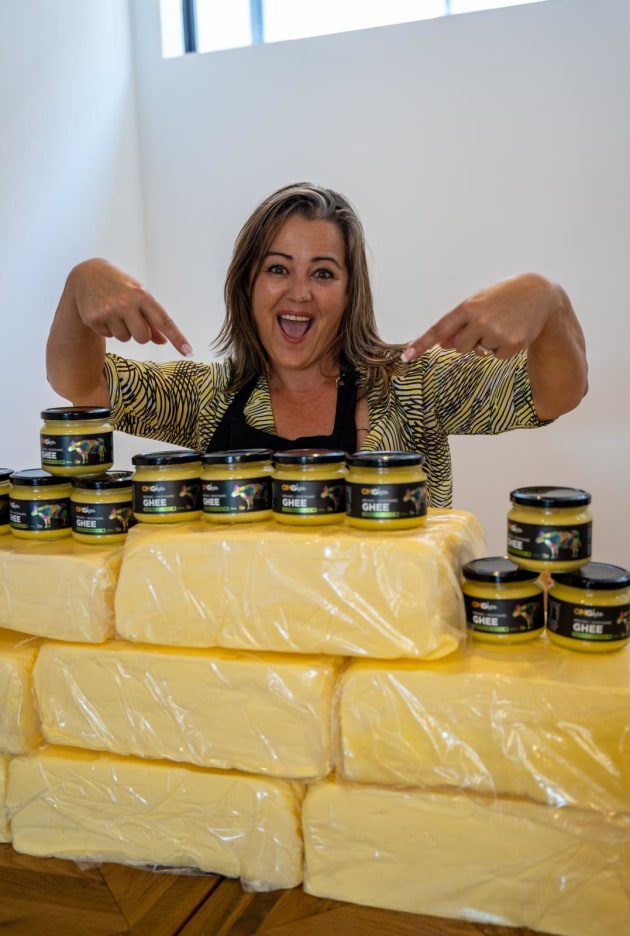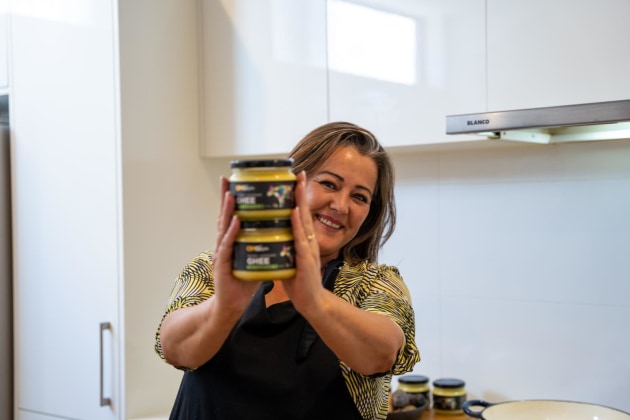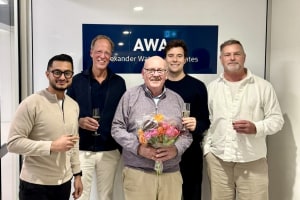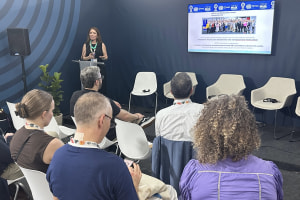A quest to improve her own health ended up putting Lisa Ormenyessy on a whole new career path. Her biodynamic and organic ghee brand OMGhee is the result. Pippa Haupt writes.
While grappling with a high pressure job in business coaching and consulting, Lisa Ormenyessy became unwell. She saw a traditional Ayurvedic doctor, who recommended eating ghee as part of her healing process.
Used medicinally for thousands of years and in everyday eating across India and the South Asian region, ghee is considered a superfood.
Ghee is made by boiling butter at a very low temperature for several hours, resulting in a lactose-free product.
Ormenyessy says the first time she ate it, it was like taking medicine.

“It was disgusting. I went back to the doctor, who reassured me they would teach me how to make my own.
“When you make ghee, you can’t leave the pot when the butter's boiling, you have to be totally present. I'm a type-A personality, so for me, the process gives me what I like to call ‘great pause’,” she says.
She knew ghee would become an all-consuming passion when she found herself in the supermarket looking at all the different butter brands and asking herself how each would respond in the pan.
“That’s when I knew I was a goner, and that ghee was going to be a serious part of my life,” she recounts.
The ghee obsession came at a crossroads for Ormenyessy.
“I wanted to go into business on my own and was thinking it would be consulting like I had been doing for the past 20 years. But that felt really hard. I said to a friend that I just wished I could make ghee and ultimately, I granted my own wish,” she says.
“I knew nothing about retail. So, that has been a big shock, but I love it and wouldn't change it for the world.”
Making ghee is a simple, but long process, and doesn’t vary much between different types or brands of butter.
OMGhee uses biodynamic butter sourced from South Australian based Paris Creek Farms, which is part of Maggie Beer Holdings. [See our May edition and the website for moreon Paris Creek Farms Organic Dairy, its use of bio-dynamic organic farming practices, and how it achieved carbon neutrality.]
Ormenyessy says as she has learned more about ghee there are myths she wants to dispel.
“The biggest misconception is that ghee is clarified butter. I want to blow that myth out of the water.
“The other thing is that it’s not just ‘butter oil’ – during the heating process, the length of the fatty acid chains are transformed, so it is a completely different product. It’s not butter, it is ghee.”
Finding a kitchen
Ormenyessy began with jars she bought fromKmart, labels printed at Officeworks, and batches cooked in her home kitchen, which she would then send to family and friends.
The business began to grow when Ormenyessy became a regular at farmers markets, but she soon realised there was a host of food safety and compliance regulations OMGhee would have to meet for commercial sales.
“Initially I was cooking the product at home. I thought I would just sell it through my website and farmer’s markets, but quickly realised it wasn’t that straightforward and I had to consider the dairy safe regulations. So, getting dairy production accreditation became the first priority.
“Then, if I wanted a retailer to stock my product, I needed a commercial kitchen,” Ormenyessy says.
The search for a commercial kitchen was arduous, with Ormenyessy saying there is a shortage of commercial kitchens for small businesses and start-ups.
“I called so many people. In the end, it was the fact I am a veteran that I found one.”
She is now using the “amazing” kitchen at her localRSL.
A watched pot
With accreditation and a commercial kitchen at her disposal, OMGhee was truly underway. There are minimal tools – the pots, cooktop, a jar labeller, and dosage machine – but what it does take is time, around 12 to 48 hours to make 300 jars.
Working on a commercial scale has also been a learning curve for Ormenyessy.
“I started with a small pot, then went up to 12-litre pots. Ithought I was so cool having 12-litre pots on every element.
“Then I was at a cooking supplies warehouse and I saw the great big 45-litre pots. I measured them up to see if they would fit on the hot plates, which they did, so I bought two of them! It meant that I didn't have to do split batches and could do one cook instead of two in the day,” she says.
“I thought bigger pots would save me time, but if anything, the process takes a little longer because it takes so long for it to come up to temperature.”

At the moment, there is a shortage of the biodynamic butter that Ormenyessy uses, with Paris Creek Farms the only dairy in Australia making commercial quantities.
To work around the supply shortage, OMGhee is releasing an organic range this month, to coincide with Organics Month. An organic dairy in Victoria is supplying the raw ingredient.
Normally, Paris Creek Farms can supply Ormenyessy with enough product for her to produce 300 jars of biodynamic ghee each month.
Jars here to stay
Ormenyessy says as production has increased, she has been exploring zero-waste methods, particularly with the large number of glass jars she uses.
She encourages customers to return empty jars and has also set up a system with a local company to repurpose them.
“A local company called Bully’s Meat, works with Indigenous communities on food security.
“Bully’s supplies them with thejars, and they take off the labels, sterilise, and reuse them,” she says.
“It would be better in terms of weight and shipping to use something other than glass, but ghee needs to be in jars, you can’t get away from that.”
As for the product itself, gheeis waste-free, with the remaining milk by-product able to be used in other cooking.
A lesson in ghee
Ormenyessy is looking for a wholesalers to make OMGhee available in the eastern states.
“I’m looking for a distributor that I can build a relationship with. I am all about education and I want to be able to talk to retailers to come up with ways we can teach people about ghee. I don't want to just hand it off to a distributor,” she says.
One of the key messages at the centre of OMGhee is ‘the cook is sacred’, which Ormenyessy says is, “an overriding philosophy on delivering the best possible ghee to you for healing and transformation”.
Ormenyessy says, “For me, making ghee has become a metaphor for life and I want to share and educate anyone who will listen.”
Ormenyessy’s ultimate goal isto get affordable ghee on the table of every household in Australia.
This article first appeared in the September edition of Food & Drink Business magazine.







